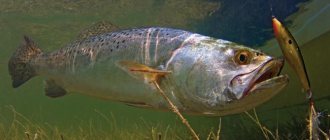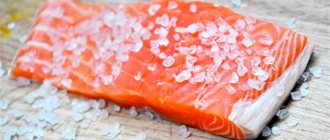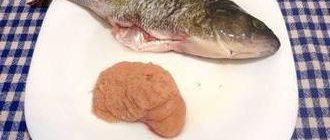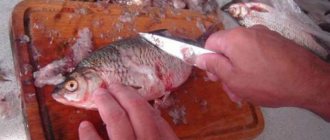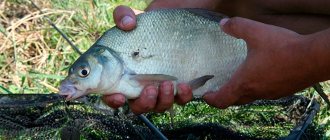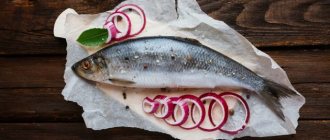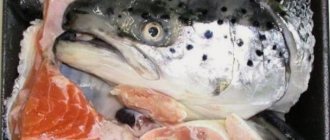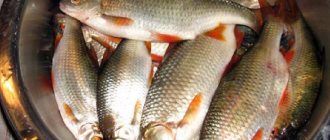Salting and drying bream
We will salt the bream whole without removing the entrails - this way the fish will turn out fatty and as tasty as possible.
The whole process will consist of several stages:
- Fish cooling;
- Pickling;
- Soaking;
- Drying.
The main difficulty in salting large fish without gutting is maintaining its freshness throughout the entire salting and drying process.
Cooling
In order for the fish to turn out without the slightest flavor, it must be properly cooled before salting. To do this, the fish is placed in the freezer for 1-2 hours, depending on the size and quantity of the fish. It is important to prevent it from freezing.
You can cool the bream in the refrigerator, but it will take more time.
Fresh bream
Fresh bream
Dried bream: salting at home - a recipe for salting and drying large fish without gutting
To get delicious dried bream at home, you need to go through several steps:
- Preparing bream for salting,
- Salting fish using dry salting method,
- Soaking the fish after salting
- Drying and drying bream
How to properly prepare bream before salting
First of all, after bringing your catch home, all the fish must be cooled. Put it in the freezer for a couple of hours.
This way your fish will be reliably preserved and odorless. And with this cooling we will get rid of some parasites if they are present in the fish.
How to properly salt bream for drying at home
Salting bream is not difficult. It is necessary to start salting with large individuals.
Next, we proceed to salting the bream. To do this, you first need to select the container size you need.
Ikea and other mega-superstores sell plastic boxes with handles. They are just perfect for salting bream - large and deep.
First of all, pour some salt into the bottom of the box. Then we fill the gills with salt, since it is from the head that the fish begins to spoil (as you and I know well).
Some immediately remove the gills and make an incision in the abdominal part so that the fish is better salted. But I assure you that it will be salted just fine anyway.
For 1 kg of fish you need 150-200 grams of salt.
Next, we lay all the fish in layers “jack” (that is, head to tail, tail to head). Don't forget to sprinkle each layer with a little salt.
When all the bream is laid, take a piece of plywood or a board of the required size and place it on top of the salted fish. We press down with our weight and place pressure on top (load - the more fish, the heavier the load).
The load should be exactly half the weight of all the salted fish.
We put it in the refrigerator for a week - no less, or even 10 days. You can spend the first two days so that the fish gives juice without putting pressure on it. But every day you need to take the fish out of the refrigerator and press it again. This is necessary so that all the air inside comes out.
I don’t do quick salting, because it seems like the fish will pick up salt in a couple of days, but fermentation of the meat will not occur and it won’t be the same dried bream like store-bought.
If there is a lot of fish, then some can be left for drying and drying, and the rest can be packed in bags and placed in the freezer. And if necessary, deliver several fish.
How to properly soak bream after salting
After salting, any fish must be thoroughly soaked. This is done so that the excess salt is removed and we do not end up with over-salted bream.
To soak bream you will need a larger container than for salting. You can set aside a bathroom in your apartment for this (if your spouse and all household members do not mind).
First, we wash each bream under the tap. Then we place it on the bottom of the bath and fill it with cold water.
The water needs to be changed every hour. Soaking is enough for 20-24 hours.
In the summer, when it is very hot, you should put a few pieces of ice in the fish bath.
The easiest way to dry and cure bream without gutting at home in summer and winter
You can dry bream in an apartment, but the best place, of course, is in a private house, where there is somewhere to hang all the fish.
Drying should be done in a cool and well-ventilated area. Small bream should be hung by the head, and large bream by the tail.
It is advisable for the fish to be dried (dried) in a room where the temperature is 10-15 degrees.
For a quick effect, especially in isolated places, such as an apartment, it is better to dry and dry the bream under a fan.
After drying, dried bream turns out to be very tasty without any odor, and when cut, the meat has an amber transparent color.
Cooking features
There are several recipes for salting bream. When gutted, the carcasses are salted faster, but in whole fish the fat content is retained as much as possible. The second method is also used when it is necessary to salt bream with caviar. To get a tasty product, you need to know the cooking features:
- it is better to salt fresh, just caught bream, since the flesh of frozen and then thawed fish will be dehydrated and with a changed structure;
- when salting large bream, it is recommended to inject brine into the back and belly with a syringe so that the flesh does not begin to rot from the inside;
- to quickly air out the carcass, it is good to direct a fan jet at it for 2-3 hours;
- To prevent drying out, it is better to store small breams in 3-liter jars with rolled-up lids, having previously removed the air from them (dip a cotton swab moistened with alcohol into the container with the fish, set it on fire and roll it up).
Knowing some tricks and secrets, you can start pickling.
Selection of containers
You can salt bream at home using any container of the required volume, except for dishes made of aluminum, galvanized steel and non-food plastic. For example, they use enamel buckets, tanks, wooden barrels, boxes, etc.
If containers made of wood are used, then the fishy smell cannot be eliminated. It is no longer suitable for pickling cabbage or cucumbers - this should be taken into account when choosing.
What kind of fish to use
With any catch, carcasses are usually found of different sizes. Therefore, it needs to be sorted immediately:
- bream up to 500 g (trifles);
- fish up to 1.5 kg (medium);
- bream over 1.5 kg (large).
Fold the caviar specimens separately. Before dry salting, it is better not to wash or wipe carcasses with a rag; it should not be wet or dry to ensure the best contact with the salt. Large specimens can be beheaded and cut lengthwise into 2 parts.
Dry method of salting bream
Moreover, an aqueous solution of salt can be prepared to your own taste. In this case, the bream pieces are ready for consumption by the time the brine has cooled. Large dried bream is very tasty. Salted bream, the recipe for which is quite simple, is prepared in a wide, not very deep container.
Bream should be dried hanging in a well-ventilated room. Using the method described above, dried bream turns out to be very tasty and fatty. At home, the best place to store dried bream may be the freezer.
Several dried bream can be stored very successfully in the refrigerator, first wrapped in parchment paper. During the cold season, you can store dried or dried bream on the balcony.
Before salting bream at home, the fish itself must be carefully prepared for this process. You will need to spend a larger amount of table salt on the last row, then press it with a lid and put some weight on it so that the salting of the bream for drying is successful.
Salting methods
There are several ways to salt fish. It is important not only to know how to pickle bream at home, but also to understand how to choose the right specimens for pickling. It is not advisable to buy fish for this purpose that is on supermarket shelves. It is recommended to salt only freshly caught fish. And it is practically impossible to determine the time when the bream was caught and placed on ice. Therefore, you need to understand that the specimen used for cooking must be caught independently or purchased live.
You can salt bream at home in gutted or ungutted form. In the first case, the fish is salted better. The technology for salting uneviscerated fish is fully justified if it contains caviar, which significantly improves the taste of the product. Either way you can cook fish of different sizes.
Dried bream at home: how to salt and dry bream safely, efficiently and tasty
Cooking dried fish (in particular bream) at home is akin to making wine. You need to approach it with feeling, sense, and alignment.)))
But in fact, in order to salt and dry bream safely, efficiently and tasty, you need to follow several rules.
There are a couple of points in salting and drying bream, or any other fish. Some people salt and dry the whole fish, while others gut it and take out the entrails.
Ungutted bream, that is, whole bream, has special gastronomic advantages. Especially if the bream is spring and with caviar.
But the gutted fish is guaranteed not to spoil during salting and is salted efficiently. But it loses fat, juiciness and all the taste of real fish.
Today I want to offer you to salt and dry the whole bream.
Recipe for dry salting bream in “diapers”
To salt bream with dry salting we need:
- Bream.
- Coarse salt.
- A towel or other fabric with a large area and the ability to absorb moisture.
- Twine.
I would like to note right away that it is advisable to take fish that you are confident in.
Opisthorchiasis
and another infection does not sleep. There is confidence that the concentration of salt will kill the pathogen, however, it is better not to take risks.
The fish does not need to be gutted. Wash it with a stream of water, dry it with a rag - that's enough.
As an example, I took the largest white bream from a fresh catch.
A layer of coarse salt about a centimeter high and an area larger than the size of the bream was poured onto a large piece of fabric.
I filled the bream with salt under the gill covers. I laid the fish on a salt “feather bed” and completely covered it with salt.
Since I’m cooking white bream, I was a little greedy with salt. If you are going to salt a large bream using dry salting, then do not skimp on the salt. There will be no excess or redundancy.
We wrap the bream tightly in a “diaper” and tie it with prepared twine.
In this form, place the fish in the refrigerator for 2 - 3 weeks, depending on the size. We do not use any oppression. We just turn it over daily from one side to the other.
Of course, the fish will begin to release juice. However, a carcass wrapped in several layers of cloth and a larger amount of salt prevent the brine from leaking out.
After two weeks, the bream has such a respectable appearance.
All that remains is to shake off the stuck salt and send the fish to the cutting board.
The meat has acquired a pleasant density and has a reddish tint.
There is no oversalting to the taste. Bream can be consumed as a separate dish or with chilled beer.
This recipe for dry salting bream can be considered correct. Moreover, the method is suitable for cooking other types of river fish - large sorog, grayling, whitefish, crucian carp, pike.
What kind of fish is suitable for salting?
Not every carcass can be used for the salting procedure; the prerequisite is fresh, unspoiled fish. However, you should not salt it immediately after catching; the bream should lie down for a while in a ventilated place. It is customary to dry whole, gutted or chopped freshwater fish. The simplest method is to take specimens about 20-30 cm and salt them without removing the insides. Only the gills of such fish are cut off and they are dried entirely. A slightly more labor-intensive method is salting gutted carcasses. It requires cutting the bream, ripping open the belly and removing all the internal organs; the gills and fins are also carefully cut off. Very large carcasses must be gutted and cut into pieces up to 8 cm thick. The product is stored longer without entrails; when preparing fish for drying in a special installation, you need to be careful not to damage the skin.
Salty
There are two methods used for salting: wet and dry salting.
Below are instructions on how to dry salt.
Ingredients:
- 1 kg of fresh bream;
- 250 grams of coarse salt.
Step by step execution:
- The fish are cleaned of mucus and internal organs, and the gills are trimmed.
- Pour a third of the salt (a little more than 83 grams) into a spacious bowl, and salt the rest of the workpieces inside and out.
- Place them entirely in a bowl, compacting them tightly and sprinkling each layer with salt, placing flat plates or cutting boards between the layers.
- Place the oppression on the top layer, not forgetting to also sprinkle the last level with salt and a small amount of sugar (it will help enhance the taste characteristics).
- Place the basin in a cool place for two days, during which time the workpiece will marinate in its own brine.
The time to prepare the dish will be from 30 minutes. Cooking time: 2 days. Number of servings: 10. KBJU per 100 g: 128 kcal/23g/3.2g/1.9g.
Drying bream
After the fish have been salted, they should be dried. For this:
- carcasses or half-carcasses are cleaned with a brush or cloth from the remains of brine and mucus;
- hang it on a strong string and take it out into the draft for 4 hours or turn on the fan for 2 hours so that the bream dries well on the outside; with the second method, the air flow will prevent flies from appearing;
- The best time to prepare dried bream is autumn, when the process can be organized on the balcony at a suitable temperature.
On a note! Since air humidity increases at night, it is better to bring the fish indoors after sunset, and again put it on the balcony in the morning.
Fillet can be dried in fruit dryers. To do this, the carcasses need to be cut into fillets, salted under pressure, washed for 1 hour, wiped with napkins, cut into strips and dried on mode 1 for 10-11 hours. Caviar is also dried.
How to Cook Dried Bream Safely
To make the product tasty, aromatic and safe for health, you should listen to the following tips:
- if the gills are not removed, then using the dry method, stuff the spice into the mouth and gills so that maggots do not appear;
- for the same purpose, the brine must be made strong, and the fish must be kept for at least 4 days;
- At all stages of cooking, flies should be prevented from appearing, for which purpose carefully cover the dishes during salting and make boxes from mosquito nets when drying and drying;
- for the same thing, after washing, the carcasses are dipped in a weak solution of vinegar and hung out to dry - the smell will evaporate after 2 hours, the scales will shine beautifully, be sure to dry completely;
- you can also mix vinegar with vegetable oil and rub the fish with it after chapping, before drying the bream;
- To avoid a musty smell, carcasses should be salted and dried in a cool place.
To improve the taste, the fish should be wrapped in paper and kept in the refrigerator for several hours.
How to dry bream without gutting
Whole fish should be dried head down, gutted or longitudinal halves should be dried up. In the first case, if the gallbladder is damaged, then only the head will be bitter; in the second, more fat is retained in the pulp, and it acquires a beautiful amber hue.
Recipe for dried bream with soy sauce and honey
For 1.5-2 kg boneless fillet you will need:
- 3 tbsp. l. soy sauce;
- 1 tbsp. l. mustard;
- 1 tbsp. l. honey;
- khmeli-suneli;
- red hot pepper;
- coriander;
- 3 buds of cloves.
First, pour coarse salt onto a baking sheet, place the fillet and generously sprinkle it with spice (about 1 tbsp) and sugar (1 tbsp). After 1.5 hours, remove the remaining salt with a knife. Then mix all the ingredients, dip the fillets in the mixture, pour in the remaining marinade, and put in the refrigerator for 6 hours. Then wipe with a cloth and hang to dry. When the product has reduced by 2 times in volume, cut and serve with beer.
How to salt bream correctly
There are so many fishermen, so many recipes; each one believes that his method is the most correct. At the same time, almost everyone agrees that before salting, bream should be cooled, but not frozen, and salt should be taken in the amount of 1-1.5 kg per 10 kg of fish. Depending on the size, one method of salting bream for drying consists of the following steps:
- Small carcasses are placed in layers in suitable containers, sprinkling each with salt so as to completely cover them. After 2 hours, take it out into the cold (8-12 degrees) and put it under pressure. After a few hours, the brine should cover the entire contents. After 2 days, rinse and hang to dry at the same temperature. After 6-7 days, place it in the sun so that the bream is covered with fat.
- Pour salt into the gills and mouth of medium-sized specimens and then salt them in the same way as breams, only first pour spices into the bottom of the container. Leave for 3 days. If salt appears on the stigmas, soak in running water for half an hour before hanging to dry.
- Large bream are decapitated and the cut area is sprinkled with salt. The more fleshy parts (the back) are pierced in several places with something sharp (an awl, a knitting needle, a knife). Salt should be the same. Leave for 3 days, wash or brush to remove mucus and dry with the tail down. After 3 days, they are pierced again with an awl or a knitting needle, then kept for a few more days until they are in good condition. If you don’t pierce it, you need to salt it for 5 days and dry it longer.
Only large spices are used so that it draws maximum moisture from the pulp. The larger the fish, the heavier the pressure should be.
Salting large bream for drying
Large bream can also be salted using the brine method. For this:
- first prepare a strong brine so that the raw egg does not sink in it (about 350 g per liter of water);
- then the brine is pumped into the fish through the anus with a syringe;
- put the carcasses in brine and take them out to a cool, dark place;
- after 2 days, the oppression is applied and left for 5 days; if the brine becomes cloudy, then it is removed and fresh is poured in;
- then washed for 2-3 hours and dried for a week or more.
Recommended reading: How to cook sea bass on the grill
At the same time, measures are taken to eliminate flies. Very large bream can be flattened, the entrails and heads removed, rubbed well with salt on both sides (300 g per 1 kg of bream) and placed flat or folded under pressure. After 3 days, soak the carcasses for 24 hours in changing water and send them to dry.
How to salt white bream for drying
An interesting recipe that combines salty and sweet. For him:
- take 5 kg of fish;
- 700-800 g of salt are mixed with 1 tbsp. l. Sahara;
- The bottom of the container is sprinkled with this mixture;
- lay the bream in layers with the belly up, sprinkling with salt and sugar;
- place the load and take it out into the cold for 3-5 days.
If you salt the bream in brine, it can also be sweetened. You will need:
- 1 liter of boiling water;
- 45 g sugar;
- 150 g salt.
Mix everything, cool, pour over the loosely laid fish, after 3 hours place the load and keep for 3 days in a cool place. You can add spices.
Salting caviar
It is better to salt bream caviar by freeing it from the roe. To do this, use any mechanical method - wipe through a colander, roll a knotted stick or fork through the mass, wrapping films around them. Then the caviar is washed and dried until crumbly. Salt (100 g per 0.5 kg of caviar), mix and take a sample after 3 hours. It is better to withstand the mass for a day.
Drying bream
After soaking, the fish is strung on hooks and hung to dry in a cool, ventilated place. It is best to hang large bream by the tail so that excess fat can drain off.
To make the fish air out faster, it is better to use a household fan. The fan allows you to significantly speed up the process of drying bream!
How to salt bream for wet smoking
Compound:
- bream – 2.5-3 kg;
- salt – 0.25 kg;
- water – 3 l;
- bay leaf – 5-6 pcs.;
- ground red pepper - to taste.
Cooking method:
- Wash the bream, gut it, dry it. Rub them inside and out with salt mixed with pepper and bay leaves crushed using a coffee grinder.
- Boil water and add the remaining salt to it. Stir until the salt dissolves.
- Remove the container with the brine from the heat and let it cool to room temperature.
- Place the prepared bream in a container or in a sufficiently capacious enamel pan. Fill with brine.
- Leave in a cool place, covered, for 7 to 14 hours, depending on the size of the carcasses.
- Rinse the carcasses, soak them for 30-60 minutes in cool water.
The fish will be ready for consumption only after smoking. For greater safety, it is better to smoke river fish using a hot method.
Salting bream for smoking
Many people ask about how to pickle bream for smoking? There are several ways to cook fish. We will look at the most popular and simplest.
Gut the fish and wash it.
If the bream is large, remove the head and make cuts on the sides. Now rub each carcass with coarse salt, including the inside.
The processed fish is placed in a deep container (tails and heads should alternate).
Cover the top with a lid and put pressure on it. Salting time is 12-16 hours - depending on the size of the fish.
Here is another way to pickle bream for smoking. It will require:
- water;
- salt;
- Bay leaf;
- red pepper.
Gutted fish should be filled with salt brine. To do this, pour water into the pan and dilute salt in it (80 grams per 1 liter of water). Add a little pepper and 2 bay leaves. Pour brine over the breams, cover with a lid and leave to brine for 7-12 hours, depending on the size of the carcasses.
After this, soak the fish in running water (30 minutes), dry it and smoke it for good health.
How to salt bream caviar at home?
So, prepare the following products:
- Caviar of one large bream.
- Sunflower oil – 4 tbsp. l.
- Salt.
- Pepper.
Cut the fish by cutting the belly and very carefully, without damaging the gall bladder, remove the caviar. Free it from the film by placing it in water and kneading thoroughly with a spoon or fork. Repeat the procedure several times. After this, put the caviar in a bowl, add salt.
Take a mixer and start beating at low speed. Continue the process until a white foam forms. Now add the oil and beat again.
Sterilize the jars, place the caviar, pour in oil so that the caviar is covered (by 5 mm). Place in a cool place for 7 days.
We hope that the question of how to pickle bream will no longer arise for you. Bon appetit!
Salting for drying
Before cooking, fish should be thoroughly prepared. To do this, rinse the bream under running water and gut it by cutting the belly and carefully removing the internal organs and gills.
You can salt fish in its untouched form. However, gutted bream is salted much faster, and the likelihood that it will spoil is very small. Salting bream at home without gutting is only relevant if caviar is present. It is with it that the taste of fish becomes rich and unforgettable.
So, take a deep pan, bowl, plate or wooden box. Add salt to the bottom. The layer should be approximately 1 cm thick. Place the previously gutted and dried bream on top, belly up. Place the fish in a row and sprinkle plenty of salt on top again. Then the next row and salt again. And so on until the fish runs out. The top layer should be generously covered with salt.
Place the lid on top and put pressure on it. Place the container with fish in a cool place for 7-10 days.
If the back is a little hard, this indicates that the fish has been well salted.
At the end of the specified time, the carcasses should be thoroughly rinsed to remove salt and left in a bowl of water for 2 hours to remove excess salt. Now the bream can be hung to dry in a dry, ventilated area. Preparation time – 7-10 days.
If you are interested in the question of how to salt large bream at home, then the cooking process is practically no different from the previous one. The fish should be gutted, washed, dried and generously rubbed with salt. Now take a bowl, add salt to the bottom and place the fish.
To salt bream, you need to take only live fish.
Be sure to cover it completely with salt. Press down with pressure and leave for 6 days in a cool place. After this, soak the bream in running water for 2-3 hours. Then repeat the procedure. Drying large bream takes 7-10 days.
Service in European style
The fishing and hunting recreation center "Uglyanskoe" invites everyone to catch bream in summer and winter. We have a school for beginner fisherman, where experienced specialists will teach you the basics of this exciting activity. We have created the best conditions for fishing lovers to spend time, we guarantee our clients comfortable accommodation, a menu of Russian and European cuisine, and the best service. The territory of the Uglyanskoye recreation center is under 24-hour security surveillance.
Quick salting
Method No. 1
- Boil the brine (1 liter of water + 40 g of salt) and immerse the carcass of cleaned, gutted and washed fish in it for a minute. Then dip it in vinegar diluted with water for a couple of minutes.
- Add another 100 g of salt to the brine, mix and place the fish in it for half an hour.
- Remove the fish from the brine and hang it in a draft under a canopy, on a balcony or loggia.
- When salt appears on the carcasses, this will mean that the fish is ready.
Method number 2
- Divide the gutted bream into halves (fillets).
- Mix 4 tablespoons of salt and two tablespoons of sugar. Rub the fish thoroughly with this mixture.
- Place the fillet in a container: the first piece skin side down, the second piece skin side up. Place a bay leaf between them.
- Cover with a cloth and leave at room temperature for a day. Then place the fish in a cool place under a light weight.
In two days the bream will be ready.
( 1 rating, average 5 out of 5 )

